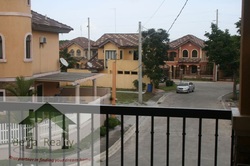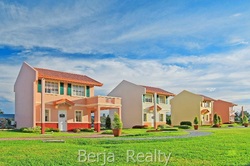CAMELLA PROJECTS IN NORTH
CAMELLA COMMUNITIES BULACAN

Bulacan is situated in the country's Central Luzon Region, north of Manila. Dubbed as the "Northern Gateway from Manila," Bulacan is indeed an ideal investment destination owing largely to having strategic location, highly productive human resources and abundant natural resources. It has emerged into a reputable resort haven of Luzon. Just a few minutes from Manila by car, Bulacan resorts provide an accessible and welcome respite from the pressures of city life.
Truly a melting pot of the past and the present, the old and the new, the countryside and the urbane - this is Bulacan. This is where Communities Philippines brings you closer to a changed environment , modern yet consoling, progressive yet still projects a rich heritage, providing you a relaxed atmosphere - Provence.
It was in 2005 after the incorporation of Crown Communities Bulacan, when we... . Read More
Truly a melting pot of the past and the present, the old and the new, the countryside and the urbane - this is Bulacan. This is where Communities Philippines brings you closer to a changed environment , modern yet consoling, progressive yet still projects a rich heritage, providing you a relaxed atmosphere - Provence.
It was in 2005 after the incorporation of Crown Communities Bulacan, when we... . Read More
CAMELLA COMMUNITIES PAMPANGA

Pampanga derived its name from the Kapampangan words "pangpang ilog" meaning "riverside" where the early Malayan settlements were concentrated along the Rio Grande de la Pampanga. Kapampangan men are known for their gallantry and leadership while Kapampangan women are famous for their beauty and skill in culinary arts.
A province rich in culture and history, Pampanga is fast becoming the business hub in North Luzon especially with the major improvement in the North Luzon Expressway, the opening of the Subic-Clark-Tarlac Expressway, and the progress of the Diosdado Macapagal International Airport. It has become the crossroad for investors bringing about rapid development and commercialization in the area, but still preserving its very colorful cultures and traditions through the celebration of its major festivals such as the Sinukwan Festival and Fiestang Kuliat, and also the very popular Christmas attraction of Pampanga, the Giant Lantern Festival.
Pampanga has become very dynamic overtime, and this is the main reason that this area serves as the perfect setting for Sorrento and Andalusia, Communities Philippines' addition. Read More
A province rich in culture and history, Pampanga is fast becoming the business hub in North Luzon especially with the major improvement in the North Luzon Expressway, the opening of the Subic-Clark-Tarlac Expressway, and the progress of the Diosdado Macapagal International Airport. It has become the crossroad for investors bringing about rapid development and commercialization in the area, but still preserving its very colorful cultures and traditions through the celebration of its major festivals such as the Sinukwan Festival and Fiestang Kuliat, and also the very popular Christmas attraction of Pampanga, the Giant Lantern Festival.
Pampanga has become very dynamic overtime, and this is the main reason that this area serves as the perfect setting for Sorrento and Andalusia, Communities Philippines' addition. Read More
Camella.
Building the Country In three powerful words, Camella’s brand tagline has encapsulated more than what it represents, more than its reason for existence -- it is also a statement of the group’s vision and its mission, and a glimpse into what the brand plans for its future…
37 years and counting. About 200 developments across the country. Over 250,000 homes built to date. A powerful presence in Mega Manila and 28 other key provinces. Over 58 cities and municipalities. A familiar household name in the country, and across borders with Filipinos abroad.
It is a story of growth, a story of vision, a story of passion. It is a story about the desire to build a home for every Filipino. To deservedly reward the hard work and perseverance of the Filipino family man. To give young families a place of their own where they can grow their dreams and tomorrows. To create communities where residents feel safe and feel they belong to.
It is also a story of evolution – from building some of the country’s finest and most desired communities to today, building cities.
It’s all part of the master plan. In real estate parlance, the “master plan” is a comprehensive plan that guides the long-term physical development of a particular area. The Camella masterplans describe residential communities that are more than a composite of homes, streets, parks, and playgrounds. Camella believes that communities should bring whatever its families need within easy reach. Thus, each community is ideally located with immediate access to crucial institutions like schools, hospitals, churches, transport hubs, and places of leisure. They are close to business centers, so work is easy to get to, and come home from. But the group has taken this a step further and exploded that strategy by bringing the institutions right into the communities. Now, when Camella builds, it also builds churches, schools and commercial centers. By creating properties that are essentially self-contained, it is creating virtual cities.
To Camella, the master plan of every single community it builds, in every single location it selects, is a sacred, living blueprint that incorporates not only what the group intends to build, but what it intends to accomplish ¬– it intends to build cities; and since a country is often known by its cities – France is Paris. Japan is Tokyo. England is London. The USA is New York, Los Angeles and Miami ¬– by building communities where they are needed, and by creating the foundations for tomorrow’s cities, Camella is building the country.
Beyond creating practically self-contained communities, Camella developments have become a “mark of progress” across the country. Camella developments often portent movement into the town, city or province they come to – they portent growth and expansion. What was once quiet and sleepy becomes bustling and dynamic. Roads get better, commercial developments crop up, utilities are upgraded, transport increases, and possibilities become endless. Lives improve, dreams become bigger, needs diversify, expectations expand, and growth becomes inevitable.
Throughout history, this is exactly how the great cities of the world came to be. A germ, a seed, set growth in motion. A few homes built along a river evolve into a great city. A tiny market along a roadway becomes a town that becomes a metropolis. A community is designed for the future and built to respond to what is needed today, and what will be needed to tomorrow ¬– and slowly, and surely, a country will be built better.
“Camella. Building the Country,” speaks of more than what the brand is all about, it speaks of what the brand promises to do.
Building the Country In three powerful words, Camella’s brand tagline has encapsulated more than what it represents, more than its reason for existence -- it is also a statement of the group’s vision and its mission, and a glimpse into what the brand plans for its future…
37 years and counting. About 200 developments across the country. Over 250,000 homes built to date. A powerful presence in Mega Manila and 28 other key provinces. Over 58 cities and municipalities. A familiar household name in the country, and across borders with Filipinos abroad.
It is a story of growth, a story of vision, a story of passion. It is a story about the desire to build a home for every Filipino. To deservedly reward the hard work and perseverance of the Filipino family man. To give young families a place of their own where they can grow their dreams and tomorrows. To create communities where residents feel safe and feel they belong to.
It is also a story of evolution – from building some of the country’s finest and most desired communities to today, building cities.
It’s all part of the master plan. In real estate parlance, the “master plan” is a comprehensive plan that guides the long-term physical development of a particular area. The Camella masterplans describe residential communities that are more than a composite of homes, streets, parks, and playgrounds. Camella believes that communities should bring whatever its families need within easy reach. Thus, each community is ideally located with immediate access to crucial institutions like schools, hospitals, churches, transport hubs, and places of leisure. They are close to business centers, so work is easy to get to, and come home from. But the group has taken this a step further and exploded that strategy by bringing the institutions right into the communities. Now, when Camella builds, it also builds churches, schools and commercial centers. By creating properties that are essentially self-contained, it is creating virtual cities.
To Camella, the master plan of every single community it builds, in every single location it selects, is a sacred, living blueprint that incorporates not only what the group intends to build, but what it intends to accomplish ¬– it intends to build cities; and since a country is often known by its cities – France is Paris. Japan is Tokyo. England is London. The USA is New York, Los Angeles and Miami ¬– by building communities where they are needed, and by creating the foundations for tomorrow’s cities, Camella is building the country.
Beyond creating practically self-contained communities, Camella developments have become a “mark of progress” across the country. Camella developments often portent movement into the town, city or province they come to – they portent growth and expansion. What was once quiet and sleepy becomes bustling and dynamic. Roads get better, commercial developments crop up, utilities are upgraded, transport increases, and possibilities become endless. Lives improve, dreams become bigger, needs diversify, expectations expand, and growth becomes inevitable.
Throughout history, this is exactly how the great cities of the world came to be. A germ, a seed, set growth in motion. A few homes built along a river evolve into a great city. A tiny market along a roadway becomes a town that becomes a metropolis. A community is designed for the future and built to respond to what is needed today, and what will be needed to tomorrow ¬– and slowly, and surely, a country will be built better.
“Camella. Building the Country,” speaks of more than what the brand is all about, it speaks of what the brand promises to do.
